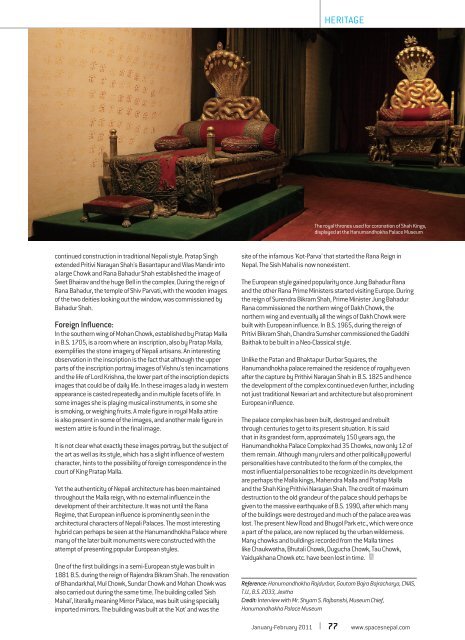1. Jan-Feb 2011
Create successful ePaper yourself
Turn your PDF publications into a flip-book with our unique Google optimized e-Paper software.
HERITAGE<br />
The royal thrones used for coronation of Shah Kings,<br />
displayed at the Hanumandhokha Palace Museum<br />
continued construction in traditional Nepali style. Pratap Singh<br />
extended Pritivi Narayan Shah's Basantapur and Vilas Mandir into<br />
a large Chowk and Rana Bahadur Shah established the image of<br />
Swet Bhairav and the huge Bell in the complex. During the reign of<br />
Rana Bahadur, the temple of Shiv Parvati, with the wooden images<br />
of the two deities looking out the window, was commissioned by<br />
Bahadur Shah.<br />
Foreign Influence:<br />
In the southern wing of Mohan Chowk, established by Pratap Malla<br />
in B.S. 1705, is a room where an inscription, also by Pratap Malla,<br />
exemplifies the stone imagery of Nepali artisans. An interesting<br />
observation in the inscription is the fact that although the upper<br />
parts of the inscription portray images of Vishnu's ten incarnations<br />
and the life of Lord Krishna, the lower part of the inscription depicts<br />
images that could be of daily life. In these images a lady in western<br />
appearance is casted repeatedly and in multiple facets of life. In<br />
some images she is playing musical instruments, in some she<br />
is smoking, or weighing fruits. A male figure in royal Malla attire<br />
is also present in some of the images, and another male figure in<br />
western attire is found in the final image.<br />
It is not clear what exactly these images portray, but the subject of<br />
the art as well as its style, which has a slight influence of western<br />
character, hints to the possibility of foreign correspondence in the<br />
court of King Pratap Malla.<br />
Yet the authenticity of Nepali architecture has been maintained<br />
throughout the Malla reign, with no external influence in the<br />
development of their architecture. It was not until the Rana<br />
Regime, that European influence is prominently seen in the<br />
architectural characters of Nepali Palaces. The most interesting<br />
hybrid can perhaps be seen at the Hanumandhokha Palace where<br />
many of the later built monuments were constructed with the<br />
attempt of presenting popular European styles.<br />
One of the first buildings in a semi-European style was built in<br />
1881 B.S. during the reign of Rajendra Bikram Shah. The renovation<br />
of Bhandarkhal, Mul Chowk, Sundar Chowk and Mohan Chowk was<br />
also carried out during the same time. The building called 'Sish<br />
Mahal', literally meaning Mirror Palace, was built using specially<br />
imported mirrors. The building was built at the 'Kot' and was the<br />
site of the infamous 'Kot-Parva' that started the Rana Reign in<br />
Nepal. The Sish Mahal is now nonexistent.<br />
The European style gained popularity once Jung Bahadur Rana<br />
and the other Rana Prime Ministers started visiting Europe. During<br />
the reign of Surendra Bikram Shah, Prime Minister Jung Bahadur<br />
Rana commissioned the northern wing of Dakh Chowk, the<br />
northern wing and eventually all the wings of Dakh Chowk were<br />
built with European influence. In B.S. 1965, during the reign of<br />
Pritivi Bikram Shah, Chandra Sumsher commissioned the Gaddhi<br />
Baithak to be built in a Neo-Classical style.<br />
Unlike the Patan and Bhaktapur Durbar Squares, the<br />
Hanumandhokha palace remained the residence of royalty even<br />
after the capture by Prithivi Narayan Shah in B.S. 1825 and hence<br />
the development of the complex continued even further, including<br />
not just traditional Newari art and architecture but also prominent<br />
European influence.<br />
The palace complex has been built, destroyed and rebuilt<br />
through centuries to get to its present situation. It is said<br />
that in its grandest form, approximately 150 years ago, the<br />
Hanumandhokha Palace Complex had 35 Chowks, now only 12 of<br />
them remain. Although many rulers and other politically powerful<br />
personalities have contributed to the form of the complex, the<br />
most influential personalities to be recognized in its development<br />
are perhaps the Malla kings, Mahendra Malla and Pratap Malla<br />
and the Shah King Prithivi Narayan Shah. The credit of maximum<br />
destruction to the old grandeur of the palace should perhaps be<br />
given to the massive earthquake of B.S. 1990, after which many<br />
of the buildings were destroyed and much of the palace area was<br />
lost. The present New Road and Bhugol Park etc., which were once<br />
a part of the palace, are now replaced by the urban wilderness.<br />
Many chowks and buildings recorded from the Malla times<br />
like Chaukwatha, Bhutali Chowk, Dugucha Chowk, Tau Chowk,<br />
Vaidyakhana Chowk etc. have been lost in time.<br />
Reference: Hanumandhokha Rajdurbar, Gautam Bajra Bajracharya, CNAS,<br />
T.U., B.S. 2033, Jestha<br />
Credit: Interview with Mr. Shyam S. Rajbanshi, Museum Chief,<br />
Hanumandhokha Palace Museum<br />
<strong>Jan</strong>uary-<strong>Feb</strong>ruary <strong>2011</strong><br />
77<br />
www.spacesnepal.com

















